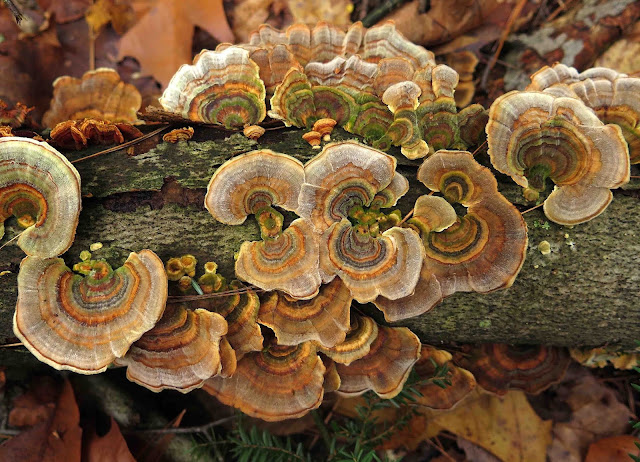Here it is already, the last day of October, and it feels as if I'm still waiting for fall: those frosty mornings and crisp, clear, blue-sky afternoons amid blazing autumn foliage. But we haven't yet had a real frost, and our tree leaves have mostly turned from fungus-spotted, insect-damaged yellowing green to withered brown. It's rainy and gray today, but last Friday was a crisp, clear, blue-sky day, perfect for a walk around Moreau Lake, where some of the trees, anyway, offered some of the brilliance we hope for each fall.
This sapling Red Maple was doing its best to remind us of what fall foliage used to look like, having somehow managed to escape some of the Gypsy Moth and fungal damage that attacked most of our mature maples this past over-heated and soggy summer.
I wonder if the continued warmth of our weather has been a factor, too, in muting the color of our fall foliage. We have not yet had a killing frost, so even a few flowers still offer their blooms to a few insect foragers, like this tiny bee in a blooming Philadelphia Fleabane. As in the case of several other spring-blooming flowers I have found recently (Bunchberry and Dog Violet, for example), this species of fleabane has started blooming again, long after its early-summer flowers had gone to seed.
I was even more delighted to find this wee little flatsedge tucked in among the dry stones higher up on the shore. For this is one of New York's rarest species, the Small-flowered Dwarf Bulrush (Cyperus subsquarrosus), only recently re-discovered to exist on Moreau Lake's shores in uncountable numbers.
Here was another great find: A male Snow Bunting, only recently arrived from its arctic breeding grounds to spend the winter here "down south."
I was able to recognize this unfamiliar bird, because exactly to the day 12 years ago, on October 29, 2009, I photographed this same species here on the shore of Moreau Lake, in almost the very same spot. (Luckily, I was able to approach the Snow Bunting much closer, back then, and got a much better photo.)
As the afternoon shadows began to lengthen, I passed this grandpa and grandson fishing by the bridge, a scene that somehow made me feel that, here in this small sun-warmed spot on the planet, all was right with the world. Maybe it just reminded me of how much I had adored my own grandpa.
While I passed through the woods on my way to my car, I came upon a fallen log populated by a long stretch of small caramel-colored fungi. They were so small and plain, I almost passed them by without more than a glance. But something about them urged me to take a closer look.
Now, here was a really colorful fungus, its lovely red cap set off beautifully by the bright-green moss behind it. Called Painted Suillus (Suillus spraguei), this mushroom has a mutually beneficial relationship with Eastern White Pines. In return for the sugars the photosynthesizing pine provides to the fungus, the Painted Suillus provides water and minerals to the tree through its underground mycorrhizal network.
Not only are fungi fascinating, some are astoundingly beautiful. And Turkey Tail Fungus is one of the most beautiful of all. I have found its thin and flexible caps adorned with stripes of many different color combinations, including royal blue and school-bus yellow or chocolate fudge and creamy vanilla. But never have I found a population colored with such a vivid and velvety moss-green, as I did this day. Wow!
















No frost here yet, but lots of bright red and orange fall colours. That Turkey Tail fungus is amazing when you look closely.
ReplyDeleteNot much color down here in PA either, but an abundance of fungi many of which are beautiful -- and that I can't identify.
ReplyDelete